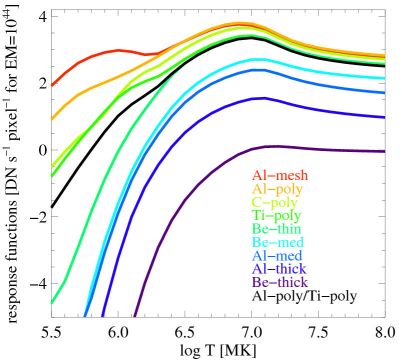
1Space Research Centre, Polish Academy of Sciences, 51-622 Wrocław, ul. Kopernika 11, Poland
2Astronomical Institute, University of Wrocław, 51-622 Wrocław, ul. Kopernika 11, Poland
Solar Physics, Astrophysics and Astronomy (Corona and transition region; Ultraviolet emission; X rays and gamma rays; Instruments and techniques)
1 Introduction
The solar corona with temperatures greater than a million degrees emits mainly in X-ray domain of the spectrum. Its emission contains both the continuum from thermal plasma and line emission of highly ionized elements. The earliest phases of solar flares are dominated by non-thermal emissions (hard X-rays), the remainder of the events manifests itself primarily by thermal emissions at wavelengths ranging from X-rays through visual. The thermal radiation comes from plasma having a wide range of temperatures.
Temperature and emission measure diagnostic of the active region and flaring loops is very important to model the loop structures, and analysis the heating sources and their (heating) distribution along the loop.
For the optically thin emission, assuming isothermal plasma temperature, the well known method of filter ratio, based on ratio of the observed fluxes in two selected energy (or wavelengths) bands (Vaiana et al. (1973), Thomas et al. (1985)) can be used. In the case of multi-temperature plasma the filter ratio method derives the line-of-sight average isothermal temperature and emission measure. Therefore, in this approach it is more adequate to use many filters or line in terms of differential emission measure distributions DEM(T)/dT (Pottash et al. (1964), Sylwester etal. (1980)). Extended discission of the DEM versus isothermal approximation can by found e.g. in Schmelz et al. (2001), Cirtain et al. (2007), and references therein.
Hinode is a new advanced optical, UV and X-ray solar satellite launched on 22 September 2006. It is equipped with three instruments: Solar Optical Telescope (SOT), EUV Imaging Spectrometer (EIS) and the X-Ray Telescope (XRT). XRT is a high resolution Wolter-I type grazing incidence telescope, which is sensible to the emission of plasma in the temperature range 5.5 < log T < 8. Such wide temperature coverage is realized by nine X-ray filters, each with its own passband and therefore a different response to plasma temperature. These filters are mounted on two filter wheels which allow many combinations of filters and thus can be used for a temperature diagnostic. Figure presents the theoretical temperature response functions of the ten XRT filters combination for unit volume emission measure of 1044 cm-3 for each filter used in this paper. XRT has 2048x2048 back-illuminated CCD array with 13.5 µm pixel size. It allows the Sun soft X-ray images to make in 34 x 34 arcmin FOV with spatial resolution of 1 arcsec. Exposure times are in range from 1 ms to 16 sec. Detailed description of the instrument can be found in the paper by Golub et al. (2007).
In this paper we will check if XRT response characteristics allow diagnostics of temperature (T) and emission measure (EM) of the coronal plasma. We also describe the observations selected for the analysis. Additionally we present and discuss filters ratio method in isothermal approximation and three different methods for differential emission measure (DEM) analysis in multitemperature approximation, respectively.
In all calculations we used the temperature response function as given by SolarSoft and presented in Figure 1.
For our work we selected three typical X-ray emitting active regions observed by Hinode/XRT with 6 or more different filters. To prepare the selected data we used standard SolarSoft routine xrt_prep.pro which is similar in nature to sxt_prep.pro (Yohkoh software). This routine converts raw data into index and structure arrays. Additionally, this process removes several instrumental effects. We could mention some of the most important, for example: replacement of the near-saturated pixels for value greater than 2500 DN with 2500 DN, remove radiation-belt/cosmic-ray and streaks, calibration for read-out signals, removing of the CCD bias, calibration of the dark current, normalization of each images for exposure time. Using processed data we calculated their differential emission measure distributions and using two filters ratio method, temperature and emission measure maps in isothermal approximation.
The filter-ratio method is a technique commonly used for plasma diagnostics based on data from broad-band X-ray imaging systems. This method requires analysis of two or more intensity maps (images) of the investigated structures obtained with various broad-band filters. It delivers maps of temperatures and line-of-sight emission integrals or emission measure distributions as a function of temperature.
For a multi-band instruments like XRT, under assumption that the emitting plasma is optically thin, the observed flux Fk in filter k in a single pixel is:
|
| (1) |
where (T,
(T,![]() ) is coronal plasma emissivity as function of the plasma temperature T and the
wavelength
) is coronal plasma emissivity as function of the plasma temperature T and the
wavelength![]() , calculated at distance of 1 AU using CHIANTI spectral code (including both
emission lines and continuum).
, calculated at distance of 1 AU using CHIANTI spectral code (including both
emission lines and continuum).
 (
(![]() ) is an effective area of the instrument which includes the geometric area and
the reflectance of the telescope mirror, the entrance and the focal plane filter
transmissions and the CCD quantum efficiency.
EM(T) is a collection of emission measures over a range of temperatures
located along the line of sight. Defining temperature response function Pk(T)
of filter k as a convolution of the instrument effective area
) is an effective area of the instrument which includes the geometric area and
the reflectance of the telescope mirror, the entrance and the focal plane filter
transmissions and the CCD quantum efficiency.
EM(T) is a collection of emission measures over a range of temperatures
located along the line of sight. Defining temperature response function Pk(T)
of filter k as a convolution of the instrument effective area
 and emissivity of solar
plasma
and emissivity of solar
plasma :
:
|
| (2) |
we can rewrite Equation 1 as:
|
| (3) |
For isothermal approximation this Equation can be written as:
|
| (4) |
Similar to using Equation 4 one can calculate ratio R of the observed fluxes (F)
in two filters labeled "1" and "2" for a co-aligned pixel area. This can be
written as:
|
| (5) |
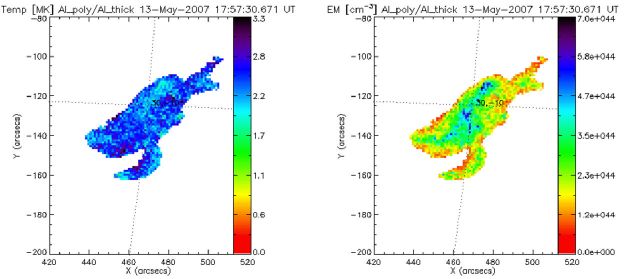
Figure 2: Temperature and emission measure maps calculated from two filters ratio, Al__poly/Al__thick for the active region NOAA 0955 observed on 13 May 2007 at 17:57:30 UT.
This procedure can be used on all combinations of the XRT filters, but it has a limited usability. Especially, ratio R can be sometimes an ambiguous function in the whole range of temperatures.
Using procedure described above we made temperature and emission measure maps for an area limited by an isoline 0.3 of the brightest pixel on the image.
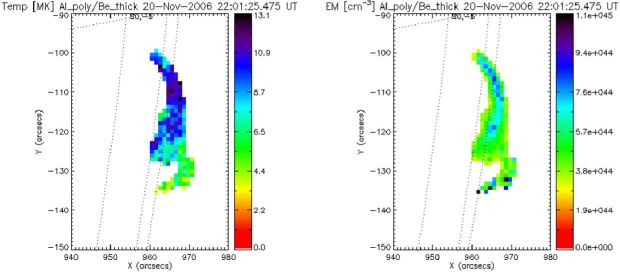
Figure 3: Temperature and emission measure maps calculated from two filters ratio, Al__poly/Be__thin for the active region NOAA 0923 observed on West solar limb on 20 November 2006 at 21:16:19 UT.
The first analysed region was a relatively faint active region NOAA 0955. Observations were made on 13 May 2007 at around 18:00 UT. Images taken in ten filters combination are available. Temperature and emission measure maps were calculated using two pairs of filters – Al__poly / Al__thick and Ti__poly / Al__thick. As an example the resulted maps for Al__poly / Al__thick pair are presented on Figure 2. For both pairs of filters the filter ratios are sensitive for temperatures from log(T)=6.1 up to log(T)=7.7. However, for all structures of this quiet active region we obtained temperatures in ranges 2.0-3.3 MK and 1.8-2.4 MK for the Al__poly / Al__thick and Ti__poly / Al__thick pairs respectively. The range of the observed temperatures is typical for solar quiet active regions (see e.g. Golub and Pasachoff (1997)).
An active region NOAA 0923 was seen on the edge of the West solar limb between 19 and 23 November 2006. Observations analyzed here were made on 20 November 2006 at around 21:16 UT. Images taken in six filters are available. Temperature and emission measure maps were calculated for two pairs of filters: Al__poly/Al__mesh and Al__poly/Be__thin. The resulted maps for Al__poly/Be__thin filters pair are presented on Figure 3. The highest temperatures range of 3.5 MK are observed in the brightest loop, seen just on the solar limb.
The same active region NOAA 0923 was observed one hour later with seven filters. Temperature and emission measure maps were calculated for two pairs of filters: Al__poly/Al__mesh and Al__poly/Be__thick. The resulted maps for Al__poly/Be__thick pair are shown in Figure.

Figure 4: Temperature and emission measure maps calculated from two filters ratio, Al__poly/Be__thick for the active region NOAA 0923 observed on West solar limb on 20 November 2006 at 22:01:25 UT.
Due to the construction of the filter wheels, XRT images in various filters are only obtained consecutively. Thus an important assumption underlying the filters ratio diagnostic (and also DEM analysis described below) is that there was no substantial change in the morphology and energetics of the event between two images using various filters. This assumption is usually fulfilled in the case of quiet Sun and active region observations. Checking the light-curves for different filters we proved that this assumption is also true in the observations above described. Moreover, in the case of small B1.5 flare images with different filters were obtained first around the maximum and the second one on decay phase of the event. We use this pair because the second filter was only one "thick" filter available. The exact co-alignment of images is likewise important, especially for the DEM calculations in the individual pixels.
Using 'harder' Al_poly/Be_thick filters pair instead of 'softer' Al_poly/Be_thin pair results in obtaining much higher temperatures. Temperatures in the brightest loop reached average values up to 13 MK. Such a high temperature could be connected to the appearance of a small B1.5 class solar flare observed in this active region. The flare started at 22:00 UT, reached its maximum at 22:05 UT and ended at 22:09 UT. In fact temperature obtained from GOES data for this small flare reached the value around 10 MK.
It is possible with XRT to register images of reasonable S/N with cadences 1 or 2 seconds. In the case of solar flares where fluxes can vary rapidly it is possible in principle to interpolate the intensities of one image to match the time at which the image in the other filter was acquired. Examples of temperature and DEM analysis of solar flare are well know in the case of Yohkoh observations (McTiernan et al. (1999)). Examples of DEM analysis with Hinode/XRT in the GOES C8.2 flare is presented by Reeves et al. (2007).
Differential emission measure, defined as DEM(T)=d(EM)/dT= ,
is a useful diagnostic tool of non-isothermal plasma. It is usually calculated
from a number of line fluxes formed at different temperature ranges. Generally
the determination of the DEM distribution is an ill-conditioned problem with no
unique solution and this problem needs some kind of regularization. Calculations
of DEM from broand-band filters observations is also possible if a corresponding
filters have different temperature response functions (see Figure 1).
In the case of
Hinode broad-band filter observation such method was worked out and tested
by Weber et al. (2004).
,
is a useful diagnostic tool of non-isothermal plasma. It is usually calculated
from a number of line fluxes formed at different temperature ranges. Generally
the determination of the DEM distribution is an ill-conditioned problem with no
unique solution and this problem needs some kind of regularization. Calculations
of DEM from broand-band filters observations is also possible if a corresponding
filters have different temperature response functions (see Figure 1).
In the case of
Hinode broad-band filter observation such method was worked out and tested
by Weber et al. (2004).
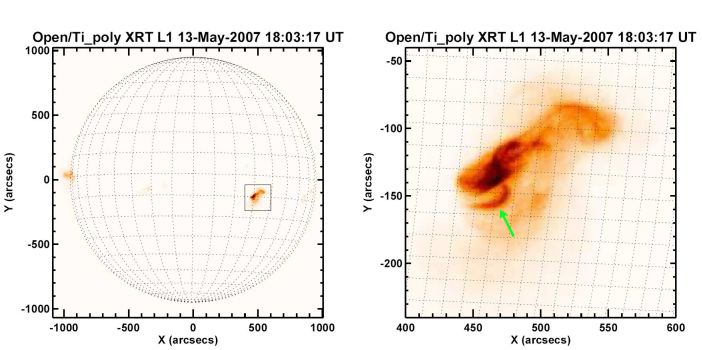
Figure 5: On the left: full Sun image obtained by XRT/Hinode with Ti__poly filter. On the right: enlarged map of NOAA 955 active region observed by Hinode/XRT telescope with Ti__poly filter. The DEM distribution, presented on Figure 7, was calculated for the loop pointed by the green arrow.
In this paper we compare three different methods of the DEM reconstruction using Hinode/XRT observations with ten filters. The methods used are as follows:
Genetic algorithm (GA) - This algorithm is based on ideas of biological evolution and natural selection mechanism. Starting from randomly chosen initial populations of different DEMs a new generation of DEMs is produced by crossover and mutations. Process of breeding (and multiplication) of the whole population is controlled by assumed fitness criterion, e.g. DEMs with higher fitness have a higher probability to participate in the process of multiplication using crossover. Examples of DEM distribution calculated with genetic algorithm cam be found for example in papers by Kaastra et al. (1996), Guedel et al. (1997) and McIntosh etal. (2000).
We used an IDL implementation of Charbonnaue’s 'PIKAIA' Fortran code
Charbonnaue (1995). Our
population had 1000 individual DEM distributions or 'genes'. After a process
of multiplication a new populations was created consisting of 90% new DEMs
and 10% of the old ones with the highest fitness. We used
 as the fitness criterion of the DEM. The process of evolution was
stopped after 10 000 - 20 000 generations, when the convergence became very
slow. The minimum values of
as the fitness criterion of the DEM. The process of evolution was
stopped after 10 000 - 20 000 generations, when the convergence became very
slow. The minimum values of
 were around 4.3; typically 15 to 30 'best' newly generated DEMs
had
were around 4.3; typically 15 to 30 'best' newly generated DEMs
had
 values below 10. The evolution process was repeated 6 times, each
time starting from a new random population. As a result we obtained 136
solutions with
values below 10. The evolution process was repeated 6 times, each
time starting from a new random population. As a result we obtained 136
solutions with
 < 10. In Figure the green line presents the mean of these
136 solutions (
< 10. In Figure the green line presents the mean of these
136 solutions ( of the mean is 4.7). The errors were calculated as a standard
deviation from the mean. The solution obtained with GA has
of the mean is 4.7). The errors were calculated as a standard
deviation from the mean. The solution obtained with GA has
 less than those obtained with WS and LS methods.
less than those obtained with WS and LS methods.

Figure 6: Images of the loop observed in active region NOAA 09555 around 18:00 UT, taken in three different Hinode/XRT filters. Contours overplotted on an Al__mesh filter image corresponds to 0.6 and 0.8 of the maximum flux of the loop.
The Withbroe - Sylwester (WS) method is iterative, multiplicative algorithm
relying on the maximum likelihood approach. In our calculations we started from
constant value DEM approximation. For detailed descriptions of this method see
Withbroe (1975) and Sylwester et al. (1980). Using WS method we performed 200
simulations consisting of 3000 iterations each. The obtained
 were in the range from 5 to 25. The mean solution has
were in the range from 5 to 25. The mean solution has
 = 10 (see Figure).
= 10 (see Figure).
Least-square (LS) method - this procedure calculates DEM basing on a
least-squares fit of the calculated fluxes to the observed ones. The method is
described in more detail by Golub et al. (2007)
and Weber et al. (2004) and and implemented as a xrt_dem_iterative
routine in SolarSoft. The DEM function is evaluated from some spline points,
which are directly manipulated by the
 are fitting the routine. Using LS method we performed 200
LS-simulations. The obtained
are fitting the routine. Using LS method we performed 200
LS-simulations. The obtained
 were in the range from 20 to 30. The mean solution has
were in the range from 20 to 30. The mean solution has
 = 25.
= 25.
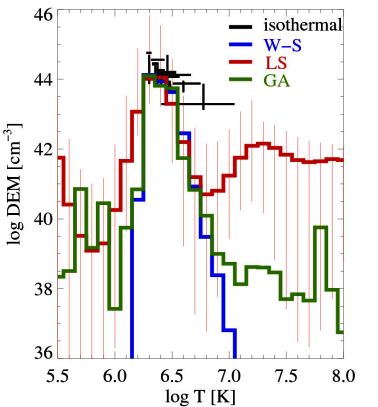
Figure 7: The DEM distributions of the loop observed on 13th May 2007 obtained using the three analysed numerical methods and using isothermal approximation with different filter pairs.
As an example we have calculated DEM for the loop observed on 13th May 2007 (see Figures 5 and 6). The flux used in DEM calculation was averaged over an area delimited by 0.8 contour level on the Al__mesh filter image (see Figure 6, left panel).
We have tested all three methods using synthetic isothermal model. The reconstructed width of the solutions allow us to estimate the temperature resolutions of the method. This resolution is low at the edges of considered temperatures range (5.5 < log T < 8) and increase in the temperatures where response functions have their maxima (see Figure 1) with best values of dlog T = 0.5-0.6, 0.2-0.3 and 0.1-0.2 for LS, WS and GA method respectively. DEM errors are similar for all three methods, and we showed in Figure 7 only error bars for LS for readness and transparency.
The uncertainties are in fact very large at lower temperatures (see Figure 7), and for this reason all three methods give solutions lying within error limits of both other methods. Thus one can not evaluate precisely EM in this temperatures range using Hinode/XRT data. However, it is well known that DEM has a minimum around log T » 5.5 for quiet Sun and active regions and for this reason each obtained solution could be right (Brosius et al. (1996), Schmelz et al. (2001)).
There are also differences in DEM solutions obtained for high temperatures. The LS solution indicates the presence of a bigger amount of the plasma having the temperatures in the range (7.0 < log T < 7.3) than the WS and GA methods. The differences are larger than estimated errors. A possible explanation of these differences is that LS models depend on initial approximation of DEM (Weber et al. (2004)). LS method has also the lowest temperature resolution comparing to WS and GA methods. The difference between all three methods should be extensively tested using XRT observations.
Obtained
 are rather high. Considering whole loop instead of one or two
pixels, the relative errors of flux decrease and thus
are rather high. Considering whole loop instead of one or two
pixels, the relative errors of flux decrease and thus
 increase (being much above 1.0). On the other side there are still
large uncertainties in the fluxes measured with Al__thick filter which strongly
influence DEM in high temperatures. Large
increase (being much above 1.0). On the other side there are still
large uncertainties in the fluxes measured with Al__thick filter which strongly
influence DEM in high temperatures. Large
 value can be also attributed to uncertainness in atomic data which
contribute to response functions and to systematic error in background rejection.
value can be also attributed to uncertainness in atomic data which
contribute to response functions and to systematic error in background rejection.
XRT telescope can detect coronal plasma of various temperatures ranging from less than 1 MK up to more than 10 MK. Applying observations made with two or more filters one can analyze coronal temperature and emission measure along a line-of-sight.
The filter-ratio method has been used frequently in the past, but the high quality XRT data give temperature and emission measure maps with unprecedented accuracy and resolution. However, filter-ratio method is not appropriate for multi-temperature structures, giving an average value of T and EM only. For such a case the DEM methods of analysis of the distribution of emission measure should be used.
The DEM distributions obtained with the described methods are presented on Figure 7. All three methods give the main peak of emission for log T = 6.3. Observed differences between results of the three methods lie more or less within error limits (please note the logarithmic scale of DEM). This figure presents also a set of isothermal solutions obtained for different pairs of filters. Their values lie around the main peak of DEM obtained with numerical methods described before. Thus, we can conclude that all three methods give results similar to the two filters ratio method.
We can also conclude that described methods of the DEM calculation gave similar
and comparable solutions. Additionally, based on shapes of the emission
functions (see Figure 1) we can expect much better
conformity of the results obtained with WS, LS and GA methods in a case of
strong flares. We can state that the majority of the pairs of the Hinode
filters allows one to derive the temperature and emission measure in the
isothermal plasma approximation using standard diagnostic based on two filters
ratio method. The temperatures evaluated with this method for two non-flaring
active region plasma were in the range from around 1.5 MK to about 5 MK.
Acknowledgements
Hinode is a Japanese mission developed and launched by ISAS/JAXA, with NAOJ as domestic partner and NASA and STFC (UK) as international partners. It is operated by these agencies in co-operation with ESA and NSC (Norway).
This paper was supported by the Polish Ministry of Science and Higher Education, grants N203 022 31/2991 and N203 015 32/1891.